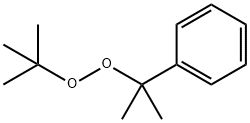|
|
| | TERT-BUTYL CUMYL PEROXIDE Basic information |
| Product Name: | TERT-BUTYL CUMYL PEROXIDE | | Synonyms: | [1-(tert-butylperoxy)-1-methylethyl]benzene;1,1-Dimethylethyl 1-methyl-1-phenylethyl peroxide;1,1-Dimethylethyl-1-methyl-1-phenylethylperoxide;Butyl cumyl peroxide;butylcumylperoxide;Cumyl tert-butyl peroxide;Kayabutyl C;Luperco 801-XL | | CAS: | 3457-61-2 | | MF: | C13H20O2 | | MW: | 208.3 | | EINECS: | 222-389-8 | | Product Categories: | | | Mol File: | 3457-61-2.mol |  |
| | TERT-BUTYL CUMYL PEROXIDE Chemical Properties |
| Provider | Language |
|
ACROS
| English |
| | TERT-BUTYL CUMYL PEROXIDE Usage And Synthesis |
| Chemical Properties | clear liquid | | Uses | 1,1-Dimethylethyl 1-methyl-1-phenylethyl Peroxide (Technical Grade) acts as a crosslinking peroxide in polymerization reactions. | | Reactivity Profile | Peroxides, such as TERT-BUTYL CUMYL PEROXIDE, are good oxidizing agents. Organic compounds can ignite on contact with concentrated peroxides. Strongly reduced material such as sulfides, nitrides, and hydrides may react explosively with peroxides. There are few chemical classes that do not at least produce heat when mixed with peroxides. Many produce explosions or generate gases (toxic and nontoxic). Generally, dilute solutions of peroxides (<70%) are safe, but the presence of a catalyst (often a transition metal such as cobalt, iron, manganese, nickel, or vanadium) as an impurity may even then cause rapid decomposition, a buildup of heat, and even an explosion. Solutions of peroxides often become explosive when evaporated to dryness or near-dryness. May explode from heat or contamination. May ignite combustibles (wood, paper, oil, clothing, etc.). May be ignited by heat, sparks or flames. |
| | TERT-BUTYL CUMYL PEROXIDE Preparation Products And Raw materials |
|